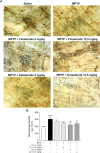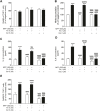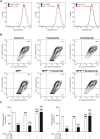Peripheral Neuroprotective and Immunomodulatory Effects of 5α-Reductase Inhibitors in Parkinson's Disease Models
- PMID: 35935876
- PMCID: PMC9355275
- DOI: 10.3389/fphar.2022.898067
Peripheral Neuroprotective and Immunomodulatory Effects of 5α-Reductase Inhibitors in Parkinson's Disease Models
Abstract
Gastrointestinal disorders in Parkinson's disease (PD) have been associated with neuronal alteration in the plexus of the gut. We previously demonstrated the immunomodulatory effect of female hormones to treat enteric neurodegeneration in the 1-methyl-4-phenyl-1,2,3,6-tetrahydropyridine (MPTP) mouse model of PD. This study made the hypothesis of obtaining similar neuroprotection as with hormone treatments by affecting steroidogenesis with two 5α-reductase inhibitors, finasteride and dutasteride. These drugs are approved to treat benign prostatic hyperplasia and alopecia and display mitochondrial effects. In MPTP-treated mice, the dopaminergic and vasoactive intestinal peptide (VIP) neurons alteration was prevented by finasteride and dutasteride, while the increase in proinflammatory macrophages density was inhibited by dutasteride treatment but not finasteride. NF-κB response, oxidative stress, and nitric oxide and proinflammatory cytokines production in vitro were only prevented by dutasteride. In addition, mitochondrial production of free radicals, membrane depolarization, decreased basal respiration, and ATP production were inhibited by dutasteride, while finasteride had no effect. In conclusion, the present results indicate that dutasteride treatment prevents enteric neuronal damages in the MPTP mouse model, at least in part through anti-inflammatory and mitochondrial effects. This suggests that drug repurposing of dutasteride might be a promising avenue to treat enteric neuroinflammation in early PD.
Keywords: MPTP; dutasteride; enteric nervous system; female hormones; finasteride; gut; inflammation; mitochondria.
Copyright © 2022 Poirier, Côté, Jarras, Litim, Lamontagne-Proulx, Al-Sweidi, Morissette, Lachhab, Pelletier, Di Paolo and Soulet.
Conflict of interest statement
The authors declare that the research was conducted in the absence of any commercial or financial relationships that could be construed as a potential conflict of interest.
Figures








Similar articles
-
The 5α-reductase inhibitor Dutasteride but not Finasteride protects dopamine neurons in the MPTP mouse model of Parkinson's disease.Neuropharmacology. 2015 Oct;97:86-94. doi: 10.1016/j.neuropharm.2015.05.015. Epub 2015 May 23. Neuropharmacology. 2015. PMID: 26006269
-
Neuroprotective and immunomodulatory effects of raloxifene in the myenteric plexus of a mouse model of Parkinson's disease.Neurobiol Aging. 2016 Dec;48:61-71. doi: 10.1016/j.neurobiolaging.2016.08.004. Epub 2016 Aug 16. Neurobiol Aging. 2016. PMID: 27644075
-
Effect of the 5α-reductase enzyme inhibitor dutasteride in the brain of intact and parkinsonian mice.J Steroid Biochem Mol Biol. 2017 Nov;174:242-256. doi: 10.1016/j.jsbmb.2017.09.021. Epub 2017 Oct 2. J Steroid Biochem Mol Biol. 2017. PMID: 28982631
-
Effect of 5-alpha reductase inhibitors in animal models of Parkinson's disease.Front Neuroendocrinol. 2024 Oct;75:101156. doi: 10.1016/j.yfrne.2024.101156. Epub 2024 Sep 29. Front Neuroendocrinol. 2024. PMID: 39353534 Review.
-
Neuroactive gonadal drugs for neuroprotection in male and female models of Parkinson's disease.Neurosci Biobehav Rev. 2016 Aug;67:79-88. doi: 10.1016/j.neubiorev.2015.09.024. Epub 2015 Dec 17. Neurosci Biobehav Rev. 2016. PMID: 26708712 Review.
Cited by
-
LHFPL2 Serves as a Potential Biomarker for M2 Polarization of Macrophages in Renal Cell Carcinoma.Int J Mol Sci. 2024 Jun 18;25(12):6707. doi: 10.3390/ijms25126707. Int J Mol Sci. 2024. PMID: 38928412 Free PMC article.
-
Three-Dimensional Analysis of Sex- and Gonadal Status- Dependent Microglial Activation in a Mouse Model of Parkinson's Disease.Pharmaceuticals (Basel). 2023 Jan 20;16(2):152. doi: 10.3390/ph16020152. Pharmaceuticals (Basel). 2023. PMID: 37259303 Free PMC article.
-
Nardostachys jatamansi Extract and Nardosinone Exert Neuroprotective Effects by Suppressing Glucose Metabolic Reprogramming and Modulating T Cell Infiltration.Cells. 2025 Apr 28;14(9):644. doi: 10.3390/cells14090644. Cells. 2025. PMID: 40358168 Free PMC article.
-
Association between finasteride with subjective memory deficits: a study from the NHANES and FAERS databases.Front Neurol. 2025 Jun 13;16:1616851. doi: 10.3389/fneur.2025.1616851. eCollection 2025. Front Neurol. 2025. PMID: 40584531 Free PMC article.
References
LinkOut - more resources
Full Text Sources

